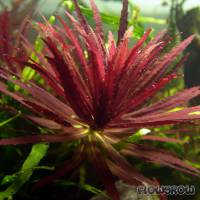



Limnophila hippuridoides is a marshweed found under various names in trade for several years: "Limnophila aromatica", "L. aromaticoides", "L. hippuroides" (incorrectly written) and even "Gratiola officinalis" (a totally different species). L. hippuridoides is native to the Malayan peninsula (Malakka). It is closely related to L. aromatica and L. aromaticoides. In botanical literature it has hitherto been treated as species in its own right. It mainly differs from the other two species in flower and fruit characteristics, however, there are also some differences to be observed in the submersed forms (according to Kasselmann 20101):
- Limnophila aromatica: 2-3 leaves per stem node, of variable colour, reddish hues or green (very variable species).
- Limnophila aromaticoides (often treated as synonym of L. aromatica): 3-8 leaves per stem node, overall plant colour is exclusively light green
- Limnophila hippuridoides: 6-8 leaves per stem node, colour reddish to intensively dark red.
Similar to both other species, crushed leaves of L. hippuridoides smell more or less distinctly aromatic.
Light is the most important aspect for successfully cultivating L. hippuridoides, however, its nutrient and CO2 requirements should not be underestimated. The injection of CO2 into the tank and sufficient levels of nitrate, phosphate and micronutrients are necessary. Especially iron is of utmost importance for colour intensity and good growth. A nutrient-rich substrate (e.g. ADA Aquasoil) will speed up growth, as this species tends to develop an ample root system. A low nitrate level or a phosphate surplus will usually cause the plant to develop a very intensive colour.
If allowed to reach the water surface, L. hippuridoides tends to form emersed leaves. The plant can also be cultivated totally emersed on a moist substrate, e.g. loam. Under lots of light it may then grow beautiful violet flowers.
L. hippuridoides is best propagated with top shoot cuttings, however, another possibility is to sow the seeds on wet loam. Make sure to plant the cuttings you took of this large stem plant in a way that they don't shade off each other. Trimming the top shoot leads to a bushy growth habit as the plant throws many lateral shoots then.
Under lots of light this marshweed assumes a stunning dark red colour, which makes it an attractive and very effective focal point in an aquascape layout for a large tank. L. hippuridoides is best placed before a dark background or as contrast against small-leaved light green plants. It can also look exceptionally nice against a backdrop of Vallisneria spp.
<a href="https://www.flowgrow.de/db/aquaticplants/limnophila-hippuridoides" target="_blank"><img alt="Limnophila hippuridoides" title="Limnophila hippuridoides" src="https://www.flowgrow.de/db/widget/aquaticplants/limnophila-hippuridoides" /></a>
[url=https://www.flowgrow.de/db/aquaticplants/limnophila-hippuridoides][img]https://www.flowgrow.de/db/widget/aquaticplants/limnophila-hippuridoides[/img][/url]
[widget=aquaticplants/limnophila-hippuridoides]Limnophila hippuridoides[/widget]